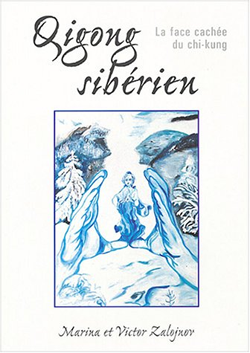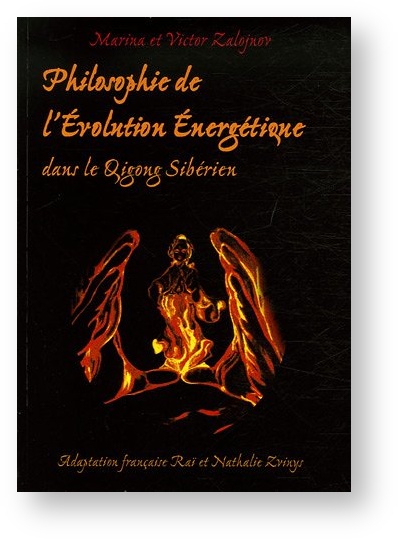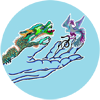Zhen Paï and Siberien Qigong
A synthesis of diverse Energy Arts with Chinese Qi Gong and Taoist traditions
Its principal idea is to enhance the capacity to feel the energy that is present in each one of us, so that manipulating all its diversity becomes evident and clear, almost material.
To feel, to distinguish and to develop the energy within and outside of the body,as well as in nature that surrounds us.To use it for your health and for your personal development.
Read more : Difference of Siberian Qi Gong and other Energy Arts
4. A state of permanent tension
In our complex and frenetic era, man is so absorbed by his daily problems that his answer to the classic question “How do you feel?” is “I don’t feel, I don’t have time!” This attitude towards oneself and one’s body seems normal as long as the body functions normally, but as soon as one gets sick, the body comes to the foreground, supplanting all else. Man only thinks about his health when he no longer has it.
After the age of thirty, or even earlier, we think it normal to have two or three chronic illnesses which, in a chain reaction, lead to others. We experience a certain secret pleasure in describing to others all the places where we hurt. When our illnesses are not due to an accident, they result from ignorance of our body or from laziness, but also from not wanting to pay attention to our body’s needs, even though we are attentive to many other things. A housewife watches over her home: she knows exactly where to find anything, what needs to be put away, cleaned or repaired. A car enthusiast knows all about his car’s mechanics. He takes care of the motor, cleans and lubricates it, because he knows that for the car to run well all these details must be taken care of.
No one would ever dream of hitting his Hi Fi set with a brick, but several times a day we attack our liver with a glass of alcohol, or our lungs with cigarettes. Or while we often do no physical exercise during the winter, during the summer we suddenly overindulge in sports, pushing ourselves until we ache all over. We overuse our nervous system to the point of exhaustion. We treat our body like a slave that we can exchange whenever we want, forgetting that it’s impossible to replace it. And in the bargain we forget that with fatigue and a body whose capacities are weakened, it’s our vitality that suffers. As a consequence our life loses a large part of its attraction and quality. Both its depth and the intensity of its colors are diminished.
We let one of the essential capacities of childhood disappear: the ability to relax. In our countries, education too often demands constant effort (physical, psychological or intellectual), creating a state of permanent tension. School children are never encouraged to stop everything and listen to what is going on within themselves. In fact we are increasingly tense; the limits our various systems (nervous, psychological, physiological and respiratory) can withstand are linked to our ability to relax, and of course to the amount of time we allow ourselves for relaxation. This applies equally to our exterior energetic field: the youth of our exterior energetic body is determined by the flexibility of the membranes in its cocoons and armatures. (In social interactions, for instance, sufficient flexibility is synonymous with the absence of fear in social contacts.) Our skin remains youthful as long as it is elastic, our heart functions well when its muscles contract and relax easily, etc. The same is true of all our organs, and even all our cells. Their membranes expand, absorbing energy and nutrients, and then contract, expelling wastes. The more relaxed the membranes are, the more active they can be.
The more a system can expand, the more viable and resistant it will be. Thus, for example, in order not to weaken the liver during its “resting period” (up to fifteen hours), it is better not activate it by getting angry, or by a massage or by running. By respecting the liver’s natural periods of rest and inactivity, we allow it to function better and with more force during its normal period of activity, evening and early nighttime.
A child’s organism is quite capable of spontaneous relaxation. When he is tired, a half-hour’s nap is enough to permit a sea of energy to burst forth, and his level of activity is re-established very quickly. But as we age, our muscles and tissues are “intoxicated” little by little. They retain accumulated tensions, no longer able to evacuate them spontaneously. They lose their facility to relax, and consequently are less and less able to withstand intense physical effort. With age we need more and more time to recuperate, especially since our rest is less complete that before: we no longer have the same elasticity and we have less resistance to outside factors.
How does tension affect us?
Woven throughout our body are energetic channels which, like blood and lymphatic vessels, flood our tissues with energy and serve as a system of informational exchanges. If these tissues are constricted by constant tension, normal energetic circulation becomes impossible in these channels. The tissues then accumulate material and energetic toxins, and this accumulation will progressively provoke the stagnation of the processes linked to an organ, often the weakest one. The tissues become covered with a film that blocks nutrition and cleansing, first energetic, then material (blood, lymph…). The nerve endings signal this blockage with painful pulsations and set off the person’s protective system. But the organ’s isolation (in terms of energetic nutritional exchange) is reinforced by the fact that the pain increases tension in the surrounding tissues. Attracted by the pain, attention is concentrated on the painful area, blocking and immobilizing the already stagnant energy.
The same is true of the entire organism, and of the outer energetic body, as well. The energetic envelopes that surround the physical body also accumulate energetic slag, and their elasticity and capacity to heal can rapidly disappear. Stress or an energetic “hit” will provoke a spasm and a deformation of the energetic cocoon

Deformation of an energetic cocoon
One of the layers (envelopes) no longer lets energy circulate in either direction, isolating and provoking a halt in the circulation of the energetic fluxes within it. This immobility spreads from the damaged membrane to the physical body, which becomes covered with a static shell that thickens and reaches all the matter in the body, starting with the skin and penetrating more and more deeply. At this point the person’s cocoon no longer resembles a variable, scintillating living vortex, but rather a dark and cold stone. Since the energetic channels no longer receive nourishment from outside the body, their energy slows down, provoking toxicity first in the channels themselves, and subsequently in the body’s cells and organs.
Which organ will first cry out in pain, pushing the alarm button and showing that something is wrong? That depends on the level of their respective weaknesses, but for the vortex, pain always signals a blockage that prevents energy from flowing.
The system’s imbalance can also be due to hypertension in just one of its parts (physical, psychological or mental)

physical psychological mental
This imbalance can be avoided if, for example, someone engaged in intellectual effort activating his brain and mental envelopes knows how to distribute this activity throughout his body and into the entire cocoon that surrounds it. Also, if the person can establish perfect circulation and a high-quality exchange between the body and its cocoons, this activity is diffused to all the sub-structures down to the cells themselves. This stimulates and balances the activation of the body and its energetic envelopes.
Often after fleeting pain (if we have even paid attention to it!), many of us have the unlikely hope that its cause will have disappeared with the pain. But beware of previously unknown kidney or liver pain appearing some time later. If we want to avoid increased pain, or pain elsewhere in the body, we must find the causes of the initial pain and treat it rapidly.
When we experience pain, we must first relax as much as possible the painful organ and its surrounding tissues, thus permitting better circulation of the energetic fluxes. While concentrating on the stagnant and painful area we must then:
• Either put the painful zone’s energy back in movement by rotating it
(Illustration 4-3a),
• Or, use an energetic flux taken from outside this area to clean the
slag and dirt, being careful to expel them from the body.
(Illustration 4-3b).
The use of painkillers is only a partial solution: they reduce the signals of pain in the brain centers and diminish tension in the surrounding areas, but since pain is no longer signaled, the organism thinks that all is well and ceases to protect itself, though the organ is continuing to deteriorate.
It is important to us to demonstrate how closely everything is connected within our physical and energetic bodies. Numerous factors (external or internal) constantly influence our energetic vortex, changing its internal circulation, its pulsations and the density of the energy field in certain zones.
A person’s entire system is balanced and mobile when there is a good exchange among its different energetic layers. Thus it is necessary to increase every energetic level’s activation (energetic exchange from one layer to another, the layers’ reciprocal nourishment) and also to reinforce the system’s cumulative strength, from its smallest components, such as atoms, up to its overall structure. There are different methods for achieving this, several of which are included in this book.
The blossoming of flowers
Future workshops
Visitors Map















